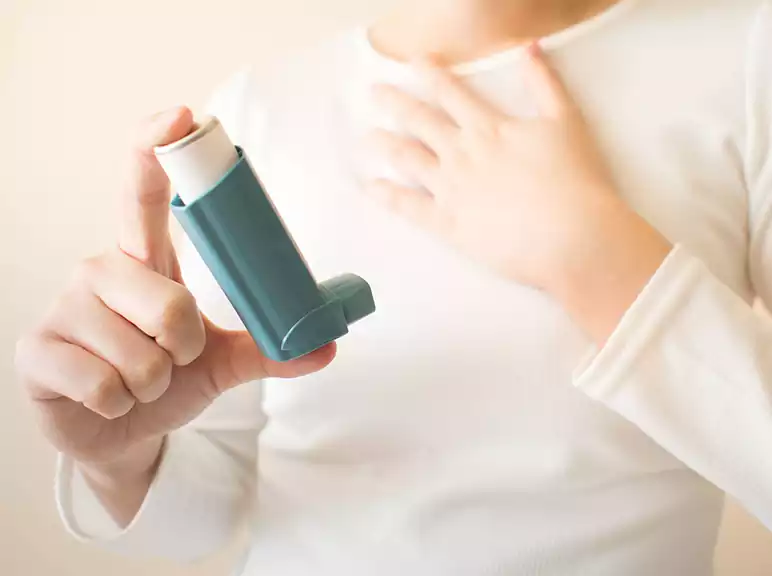Asthma and COPD
Asthma-COPD overlap (ACO), formerly called asthma-COPD overlap syndrome, occurs when you have signs of both asthma and chronic obstructive pulmonary disease (COPD).
The only thing these two lung conditions have in common is that they find it difficult to breathe. Yet they’re different in many ways.
Asthma is a serious lung disease which causes reversible
airway narrowing, inflammation of the airways, and mucus development.
Some signs of asthma are shortness of breath, squeezing of the throat, and wheezing.
Most people with asthma suffer from exacerbations or flare-ups.
There are periods when the symptoms are worse than usual.
These are also periods when there are few to no signs.
Chronic bronchitis and Emphysema are two primary disorders under the COPD umbrella. COPD can cause shortness of breath, tightening of the chest, mucus production, and persistent coughing. COPD is a progressive disease. People with COPD have typical symptoms, and they also experience flares.
Symptoms of ACOS typically include:
- wheezing
- laboured breathing
- tightness in the chest
- coughing, with or without mucus
Symptoms may vary from day to day and typically includes flare-ups. There are also crucial differences in the symptoms between asthma and COPD.
If one only has asthma, symptoms often change, and one may be symptom-free for an extended period. Asthma is often triggered if it involves triggers like exposure to allergens, a respiratory illness or exercise. It can begin in adulthood, but asthma usually starts in childhood. People with asthma usually have allergies, and a skin condition called eczema.
If one has COPD, symptoms usually start after the age of 40. Symptoms may differ from day to day, but they’re progressive and chronic, even with treatment. Most people with COPD usually have a history of smoking or are exposed to smoke.
ACOS has the characteristics of both COPD and asthma. People with ACOS experience some ongoing airway obstruction.
They also experience wheezing, or breathing difficulties, that often respond to bronchodilators. Medications that open the airways are known as Bronchodilators.
People with ACOS seem to be younger and experience more shortness of breath than people with COPD alone.
Causes
ACOS, makes it harder to move air in and out of the airways in the lungs. It happens because the airways may be more narrow than usual and maybe swollen or are blocked by mucus.
One usually gets asthma because of allergies. The lungs may react to things like dust, cat hair, exercise, or even laughing.
COPD is caused by breathing fumes that irritate the lungs. The most common cause is tobacco smoke. But COPD may also come from toxins or air pollution at work. An individual suffering from asthma when they are young raises their chance of COPD.
When a person has COPD, their airways may get less stretchy or elastic over time and makes it tough to exhale air out and empty the lungs. It results in a person not taking in as much oxygen that is required. Another result is that the waste product carbon dioxide builds up. Too much carbon dioxide left in the body can make one feel weak.
It’s not clear what causes ACO. Having COPD for an extended period may change the way the lungs work and make a person more likely to develop it. Or it might start if a person smokes while they have asthma.
Treatment
Because asthma causes inflammation, one would still need an asthma treatment. It includes:
- Avoiding of allergens
- Medications for allergy
- inhaled corticosteroids
- short-acting bronchodilators
- long-acting bronchodilators
- preventive vaccines, such as pneumonia, flu and whooping cough
You may also need to manage symptoms of COPD to maintain lung function. It may involve:
- disease management training
- pulmonary rehabilitation
- avoid smoke and other pollutants
- eat healthy
- oxygen therapy
- long-acting bronchodilator combinations
- inhaled corticosteroids
- preventive vaccines, such as flu, pneumonia, and whooping cough
- Removal of damaged lung tissue or air sacs
Treatment for ACOS would be tailored to your preferences and symptoms. ACOS requires careful management and adherence to therapy.
Tips for managing ACOS
After a diagnosis of ACOS, our general medicine doctor will instruct you on how best to manage your condition. Take medication as prescribed and do a follow up regularly.
Here are some other tips for managing ACOS:
- A healthy diet.
Eating healthy will help one improve health. The doctor may recommend dietary supplements as per your nutritional requirements.
- Get vaccinated.
Additional respiratory illnesses may become dangerous. To lower the risk of contracting influenza, pneumonia, and whooping cough, talk to the doctor about vaccinations for these and other illnesses.
- Avoid smoke and other pollutants.
Avoid smoke and other pollutants that may irritate your lungs and make the symptoms worse.
- Exercise. Physical activity is essential for health. But you do not want to overexert yourself either. Consult the doctor to know what activities are safe to do.
- Seek support. Whether it’s friends and family, psychological counselling, or a support group, it is a good idea to reach out for support. Also make sure those closest to you are aware of your condition and what to do in an emergency.








